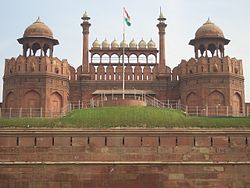Humayun's Tomb
Humayun's Tomb is the
tomb of the
Mughal Emperor Humayun. The tomb was commissioned by Humayun's wife
Hamida Banu Begum in 1562 AD, and designed by Mirak Mirza Ghiyath, a Persian architect. It was the first garden-tomb on the
Indian subcontinent, and is located in
Nizamuddin East,
Delhi,
India, close to the
Dina-panah citadel also known as
Purana Qila (Old Fort), that Humayun founded in 1533. It was also the first structure to use red sandstone at such a scale
. The tomb was declared a
UNESCO World Heritage Site in 1993, and since then has undergone extensive restoration work, which is still underway. Besides the main tomb enclosure of Humayun, several smaller monuments dot the pathway leading up to it, from the main entrance in the West, including one that even pre-dates the main tomb itself, by twenty years; it is the tomb complex of
Isa Khan Niyazi, an
Afghan noble in
Sher Shah Suri's court of the
Suri dynasty, who fought against the Mughals, constructed in 1547 CE.
Humayun's Tomb
The complex encompasses the main tomb of the Emperor Humayun, which houses the graves of his wife, Hamida Begum, and also
Dara Shikoh, son of the later Emperor
Shah Jahan, as well as numerous other subsequent Mughals, including Emperor
Jahandar Shah,
Farrukhsiyar,
Rafi Ul-Darjat,
Rafi Ud-Daulat and
Alamgir II. It represented a leap in
Mughal architecture, and together with its accomplished
Charbagh garden, typical of
Persian gardens, but never seen before in India, it set a precedent for subsequent Mughal architecture. It is seen as a clear departure from the fairly modest mausoleum of his father, the first Mughal Emperor,
Babur, called
Bagh-e Babur (Gardens of Babur) in
Kabul (Afghanistan). Though the latter was the first Emperor to start the tradition of being buried in a
paradise garden. Modelled on
Gur-e Amir, the tomb of his ancestor and Asia's conqueror
Timur in
Samarkand, it created a precedent for future Mughal architecture of royal
mausolea, which reached its zenith with the
Taj Mahal, at
Agra.
The site was chosen on the banks of Yamuna river, due to its proximity to
Nizamuddin Dargah, the mausoleum of the celebrated
Sufi saint of Delhi,
Nizamuddin Auliya, who was much revered by the rulers of Delhi, and whose residence,
Chilla Nizamuddin Auliya lies just north-east of the tomb. In later Mughal history, the last
Mughal Emperor,
Bahadur Shah Zafar took refuge here, during the
Indian Rebellion of 1857, along with three princes, and was captured by
Captain Hodson before being exiled to Rangoon. At the time of the
Slave Dynasty this land was under the 'KiloKheri Fort' which was capital of Sultan Kequbad, son of Nasiruddin (1268–1287).
Humayun's Tomb (front view)
For Tour Packages kindly contact me Sujat Amin
Mantoo by email at: mossesmantoo@yahoo.co.in
or via cellular/mobile phone: +91-9560275073
Sujat Mantoo
.
